The National Museum of Nature and Science in Japan is a treasure trove of knowledge showcasing fossils, astronomy, and scientific wonders. The museum invites visitors to explore the past, present, and future through exhibits on paleontology, biodiversity, and innovation, offering interactive displays and hands-on experiences for all ages, leaving a renewed sense of wonder and awe upon departure.
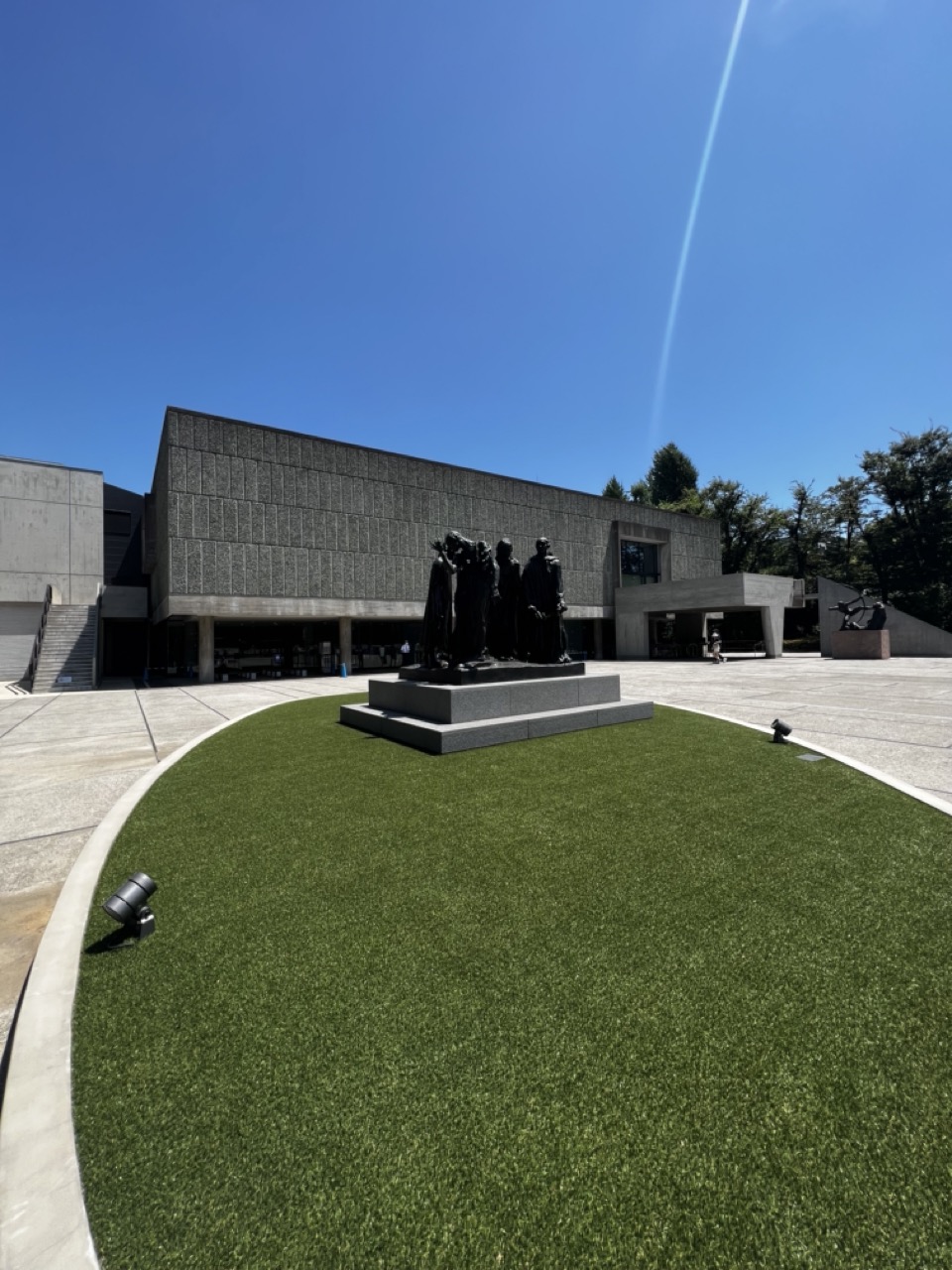

A bronze sculpture group depicting multiple figures stands stoically on a multi-tiered granite pedestal, the central subject in this bright, expansive outdoor shot. Rating the subject as captured: 7/10. Set against the formidable backdrop of a large, textured concrete building, perhaps a museum or government institution, the scene unfolds on a clear, sunny day. The immediate foreground features a dramatically curved expanse of vibrant green, artificial-looking turf, bordered by clean concrete paving that sweeps around the base of the sculpture. The overall mood is one of formal, institutional grandeur, slightly softened by the cheerful blue sky and the unexpected pop of synthetic green grass. Various elements populate the scene, including ground spotlights aimed at the turf, and in the distance, another sculpture can be glimpsed to the right of the main building.
From a photographic perspective, this image presents some classic bright-day challenges. The composition uses the curved green lawn effectively as a leading line towards the sculpture and building, though the wide-angle perspective seems to slightly exaggerate its curve. The harsh, direct sunlight creates strong contrasts, leaving some areas in deep shadow while others are brightly illuminated. The vivid blue sky is almost blown out in places, and the prominent lens flare slicing across the upper right adds an unintended, if energetic, diagonal element. The palette is dominated by the cool greys of the architecture and pavement, the dark tones of the bronze, and the intense artificial green and blue, creating a high-contrast visual. Capturing detail in both the bright sky and the shadowed areas simultaneously is tricky under these conditions, highlighting the limitations of a single exposure in extreme light.
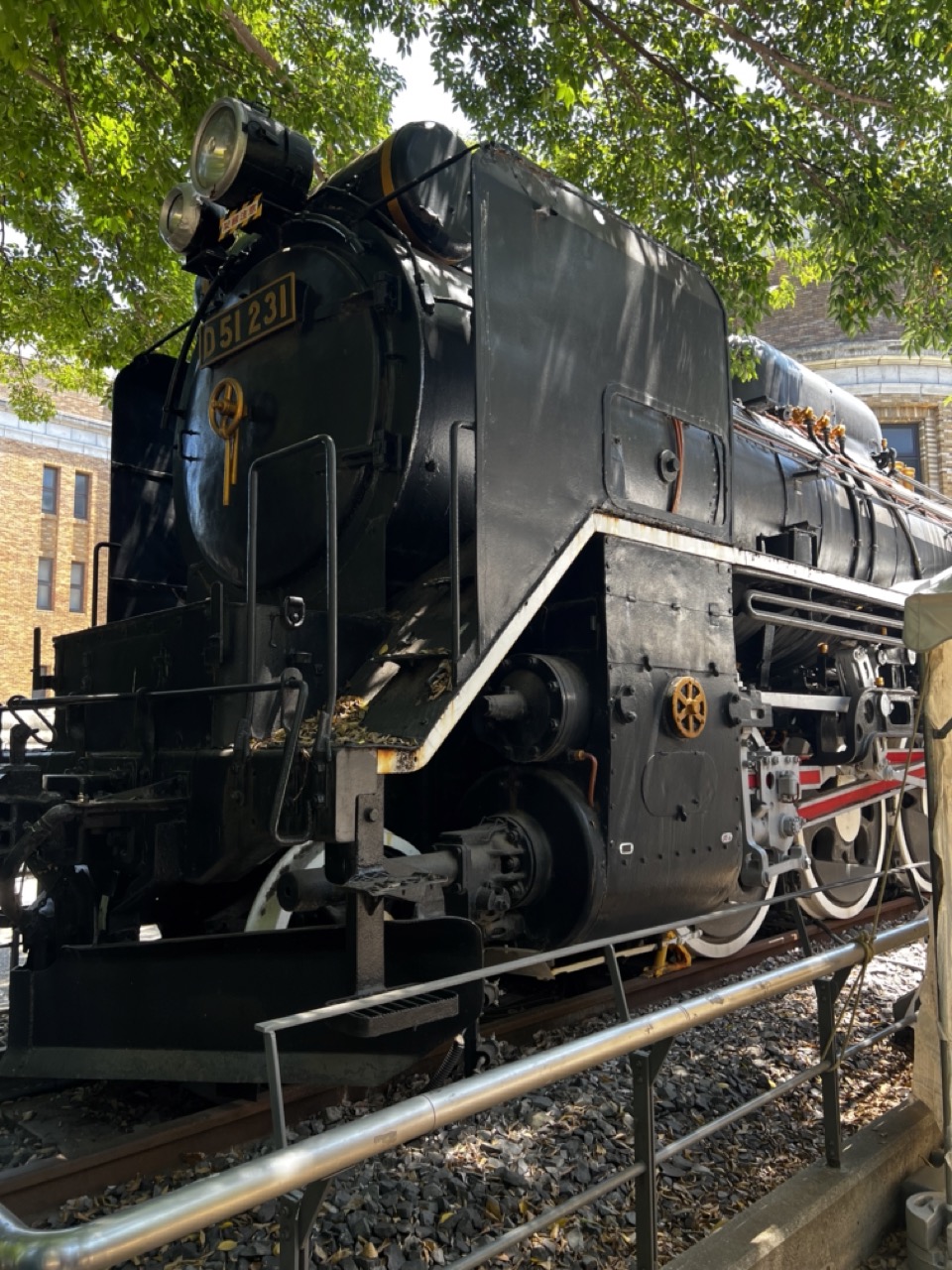

Title: The Iron Horse's Grand Nap
Rating: 8/10
Here we have a glorious subject, the formidable D51 231 steam locomotive, standing stoically on display. Rating: 8/10 – because who doesn't love a giant, old-school iron horse? What's happening is less 'full steam ahead' and more 'majestic rest stop', presumably retired from service and now a fascinating relic for public admiration. The mood is undeniably nostalgic and impressive, a tangible link to a bygone era of powerful rail travel, evoking images of steam billowing and tracks rumbling beneath its weight.
From a photographic standpoint, the low angle composition successfully captures the train's imposing scale, making it feel like the mechanical giant it is, while the strong sunlight picks out details like the headlights, number plate, and the intricate workings of the wheels and rods. However, the foreground railing acts as a rather insistent chaperone, photobombing the lower section and reminding us that we can't just wander onto the tracks – a common compositional challenge when admiring exhibits. The lighting, while great for highlighting the black ironwork and yellow accents, is a tad harsh in places, casting strong shadows typical of a sunny day snapshot. The backdrop of lush green trees provides a vibrant, natural frame, contrasting nicely with the industrial subject and the solid brick building behind. It's a good capture of an impressive machine, a snapshot that prioritizes getting close to the subject, even if it means a slightly tight crop.
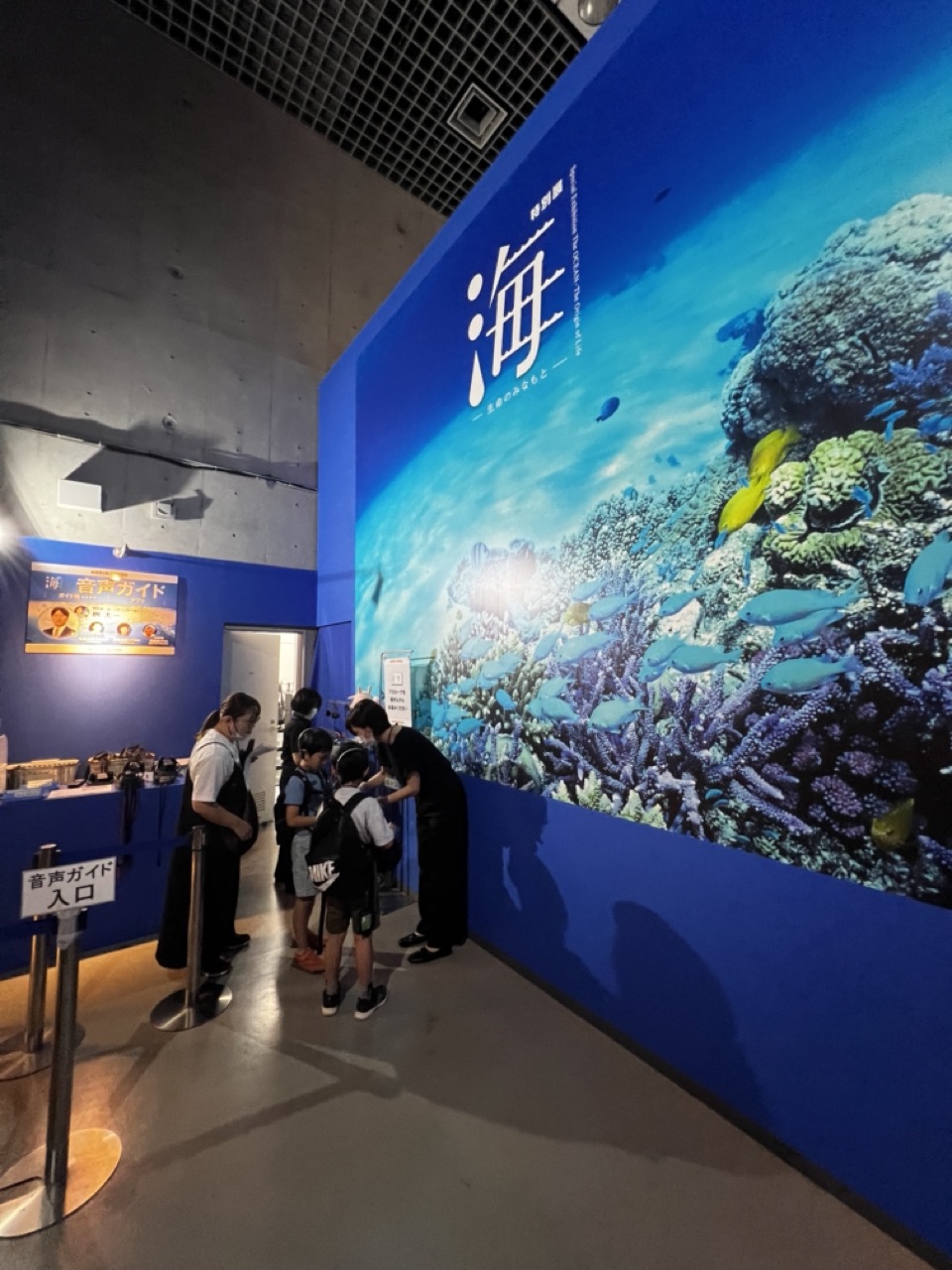

Title: Deep Dive into the Exhibition Queue
Rating: 6/10
This photograph captures a moment of anticipation at what appears to be an exhibition or museum entrance. The main subject is a group of people, including adults and children, gathered near a massive, vibrant wall display depicting a thriving coral reef with schools of bright blue and yellow fish under sunlight. The tone is one of casual engagement and preparation, as some individuals seem to be interacting with staff or audio guide equipment, while others are waiting. In the foreground, a sign clearly indicates "音声ガイド 入口" (Voice Guide Entrance), hinting at the multimedia experience awaiting visitors. The sheer scale and intensity of the ocean image dominate the scene, creating a sharp visual contrast with the more mundane reality of the queue and the surrounding architecture.
From a photography perspective, this is a very candid, available-light shot, likely taken quickly. The composition, shot from a low angle, emphasizes the imposing height of the wall display and the people in relation to it, although it also includes a significant portion of the floor and an awkwardly cut-off view of the ceiling's grid structure. The foreground "Voice Guide Entrance" sign acts as a bit of a visual barrier, drawing the eye but potentially cluttering the scene. Lighting is functional but not particularly artistic, with some shadow play on the blue wall and potentially harsh reflections on the floor. The colors are dominated by the intense blues of the wall balanced against the neutral grays of the room, with pops of color from the fish and people's clothing. It effectively documents the experience of arriving at the exhibit, even if the framing feels a little rushed, perhaps suggesting the photographer was eager to get past the queue themselves.
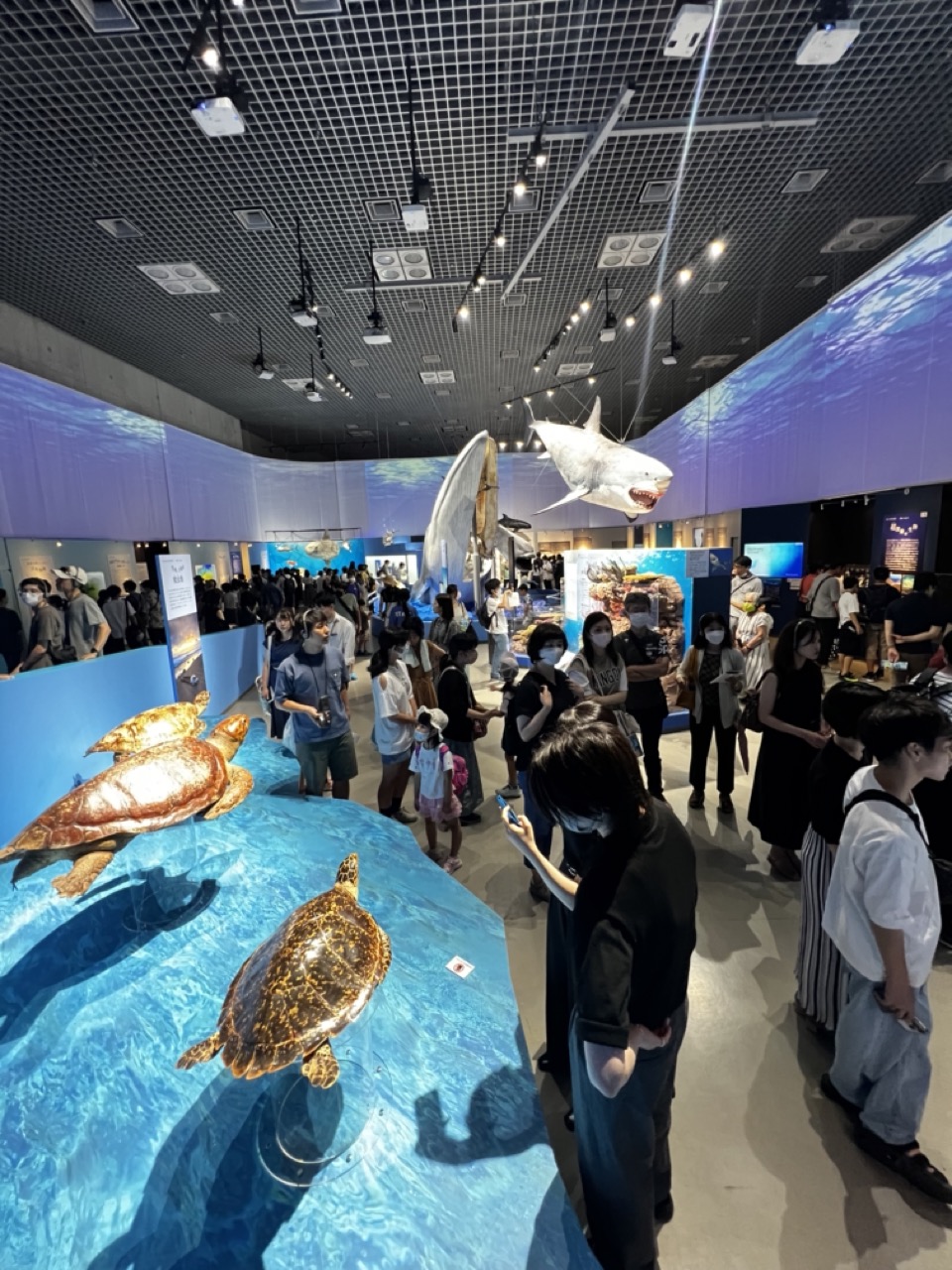

Museum Mayhem: A Deep Dive (into Crowds)
Rating: 7/10
This image drops us right into the deep end of a bustling marine life exhibition, where the true challenge isn't spotting a rare fish, but navigating the dense schools of fellow humans. The subject, rated a solid 7 out of 10 for its inherent visual interest, is a popular natural history museum or aquarium exhibit packed with visitors marveling at impressive models of sea creatures. In the foreground, two detailed turtle models rest on a bright blue display, seemingly oblivious to the surrounding hustle. Towering above the crowd are spectacular, larger-than-life models of a great white shark and a whale, suspended dramatically from the ceiling, perhaps contemplating their escape from the human tide below. The scene is alive with activity as people mill about, gazing at displays, and, of course, documenting their visit with phone cameras, adding to the vibrant, slightly overwhelming atmosphere.
From a photographic standpoint, this shot is a candid slice of museum life, captured with a dynamic perspective that pulls you into the scene. The composition effectively showcases the scale of the exhibits against the backdrop of a large crowd, though it leans more towards documentary chaos than refined artistry – the ceiling grid and scattered lighting fixtures are proof of that. The lighting is a tricky mix of exhibit spotlights, ambient light, and the glow from large projected screens, creating varying light levels that challenge the camera's sensor. While the focus isn't razor-sharp on any one element, the image successfully conveys the energy and visual richness of being inside a popular, crowded attraction, perfectly capturing that universal experience of craning your neck to see past someone else to get a good look at something fascinating.
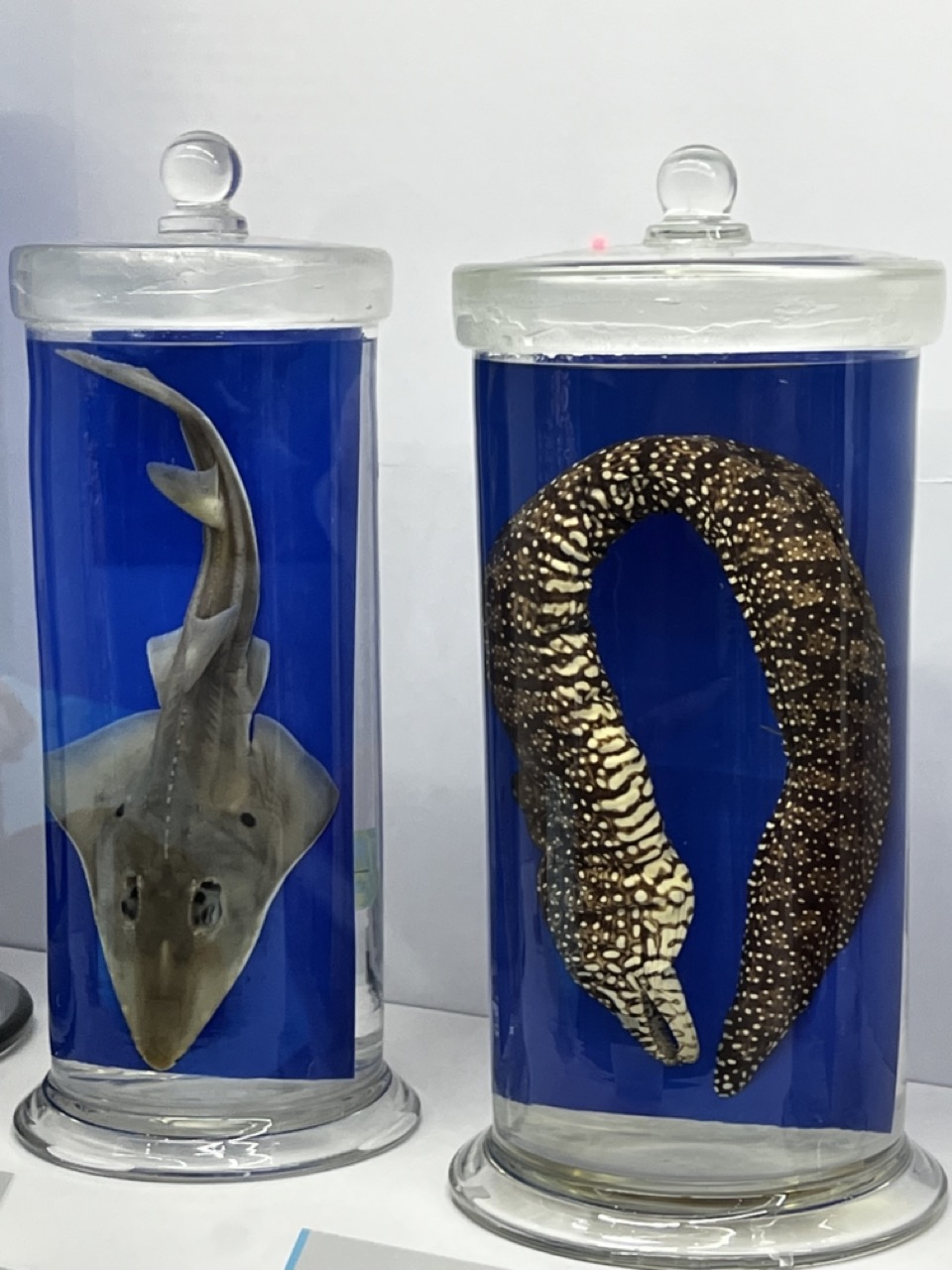

Title: The Blue Aquarium of the Damned
Rating: Subject Interest 6/10
Welcome to the eternal aquarium, where marine life enjoys a permanent vacation in unsettlingly blue jars. On the left, we have a flat friend, possibly a brave little skate or ray, seemingly attempting to swim up the side of its glass prison with limited success. Its expression is one of mild surprise, perhaps at finding itself preserved for all eternity in liquid Smurf. Next door, a dramatically coiled moray eel strikes a pose that says, "I was fabulous even in death." Its striking spotted pattern stands out vividly against the artificial blue, a stark reminder that even after shuffled off their mortal coil, some creatures just have better fashion sense. The overall mood is a quirky blend of educational exhibit and something you might find in a slightly eccentric scientist's basement.
From a photographic standpoint, the composition is clean and centered, presenting the subjects head-on in a classic display style. The lighting is even and diffused, which is great for showing detail on the specimens but lacks any dramatic impact; these guys aren't going anywhere, so perhaps some side lighting could have emphasized their forms more. The dominant, almost glowing blue is the star color, making this image pop but also feeling quite artificial, which is likely the point given the preservation liquid. It's a straightforward, documentary-style shot, effective for cataloging or display, prioritizing clarity over artistic interpretation. The white background keeps distractions minimal, focusing all attention (and slight unease) on our preserved pals.
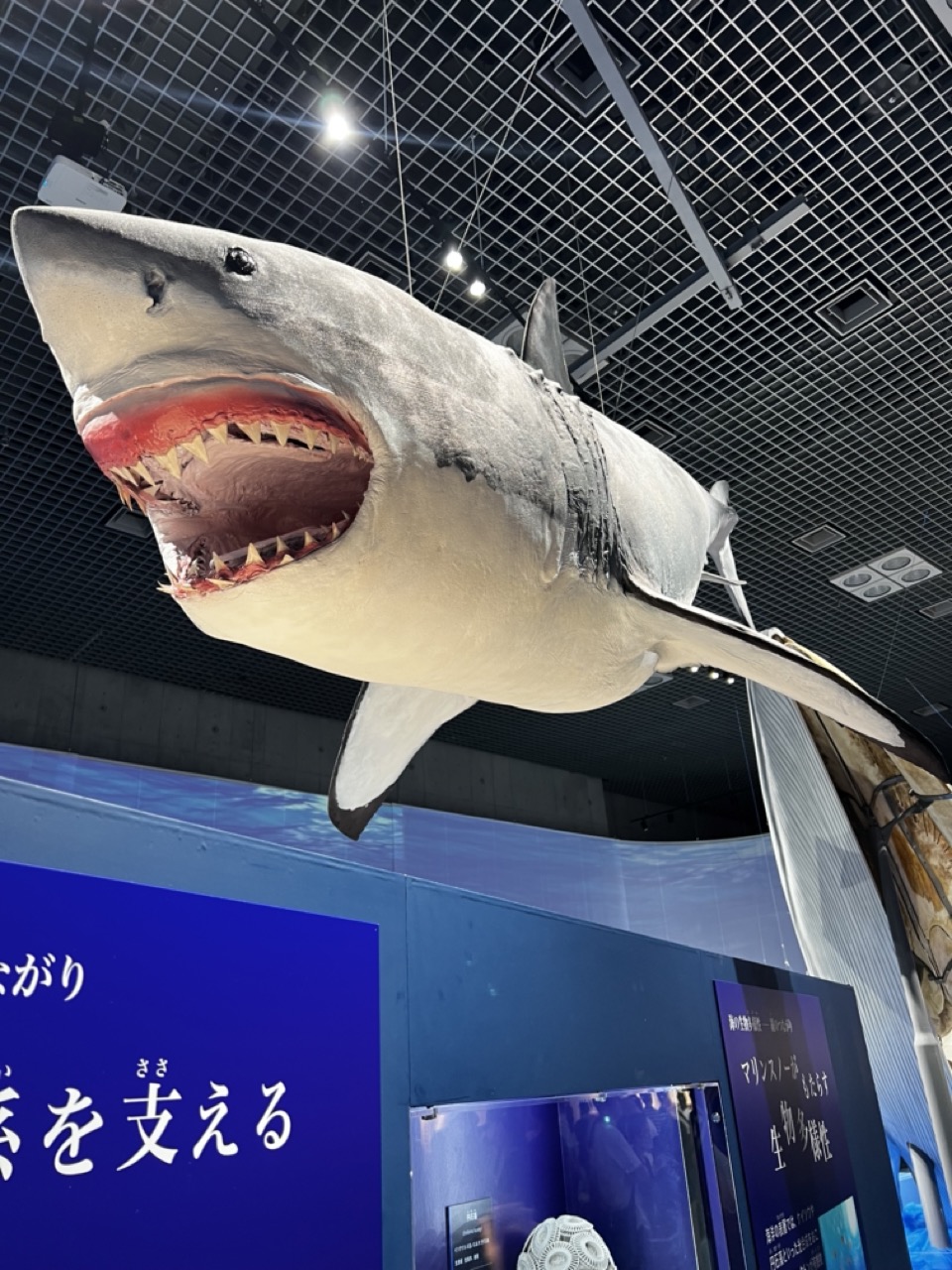

Title: The Suspended Predator
Rating: Subject Matter 9/10
Here we have a commanding view of a rather toothy subject – a massive great white shark model, dramatically suspended from the ceiling in what appears to be a museum or aquarium exhibit. Posed with its formidable jaws agape, showcasing rows of menacing teeth and a vibrant pink interior, it certainly demands attention. The mood is one of awe and slight intimidation, capturing the raw power often associated with these ocean giants, even in model form. Below the suspended beast, blue exhibit walls feature Japanese text and display cases, providing an educational backdrop to the main event, while overhead, a grid of lights adds to the institutional atmosphere.
From a photographic perspective, the composition takes a bold low-angle approach, looking up into the shark's maw, which effectively enhances its imposing scale, though it makes fitting the entire scene in cleanly a bit tricky in this frame. The lighting does a great job of spotlighting the shark itself, particularly those pearly (or rather, serrated) whites inside its mouth, creating a dramatic focal point against the darker background. The color palette is dominated by the stark grey and white of the shark contrasting with the deep blues of the exhibits, anchored by the stark black and white grid ceiling. It's a style indicative of a quick, perhaps handheld shot attempting to capture a grand exhibit piece, succeeding in highlighting the subject's key features despite the environmental challenges of a museum setting. Capturing something this big, this high, with other museum-goers potentially around, is always a bit of a compositional puzzle – trying to frame the main subject without too many distracting elements below or awkward cropping, a challenge met here with mixed results but undeniable impact.
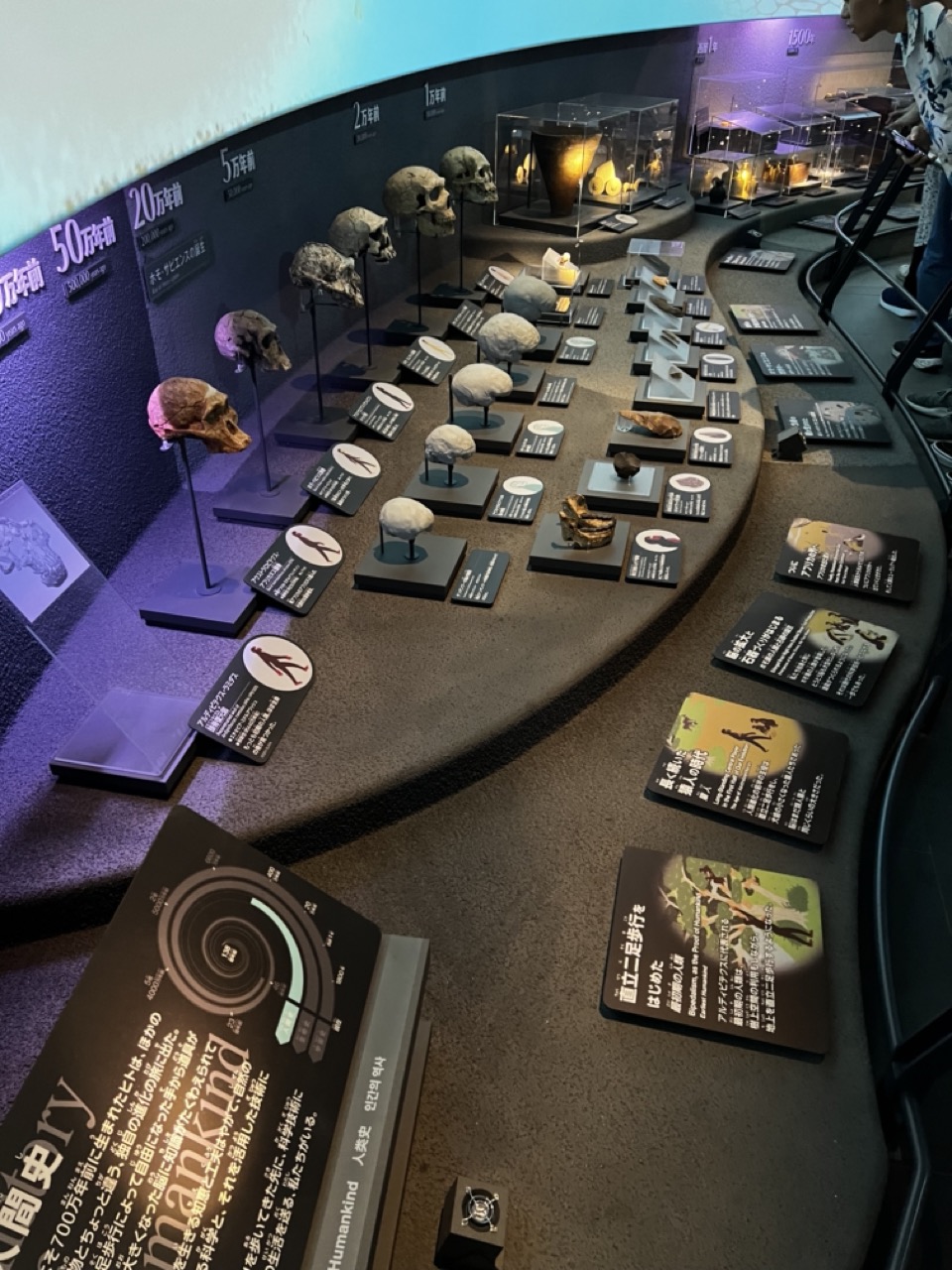

History of Us (But Mostly Our Heads)
Rating: 8/10
Stepping into this exhibit feels like crashing the world's oldest family gathering, where everyone's a bit skull-faced and doesn't say much. The subject matter, tracing the epic saga of human evolution, is undeniably fascinating – a solid 8/10 for sheer 'mind blown' potential. We're looking down a curved display showcasing the cranial highlights of our ancestors, from the earliest hominids to *Homo sapiens*. It's a chronological lineup of noggins, interspersed with artifacts like ancient tools and informational panels explaining everything from bipedalism to, presumably, why we still trip over things. The mood is one of historical reverence, a quiet journey through millions of years, punctuated by dramatic spotlighting that makes each skull look like it's auditioning for a historical drama.
From a photographer's perspective, this scene offers a compelling visual narrative, even if capturing it perfectly without disturbing the solemn skulls is a challenge. The composition utilizes the natural curve of the exhibit space, drawing the eye along the timeline. The line of skulls provides a strong repetitive element, offset by the various objects and panels below. Lighting is the star here, with dramatic spotlights isolating the exhibits against a dark, moody background infused with cool blue and purple hues, giving it that classic museum vibe. However, this high contrast lighting means tricky exposures and potentially blown-out highlights on lighter artifacts. The large spiral graphic in the foreground adds an interesting visual anchor, hinting at the vast timescale covered. Overall, it's a well-designed exhibit, and this photo captures its essence, making you feel both small in the face of deep time and oddly proud of our species' journey (despite the occasional evolutionary missteps, like the persistent inability to find matching socks).
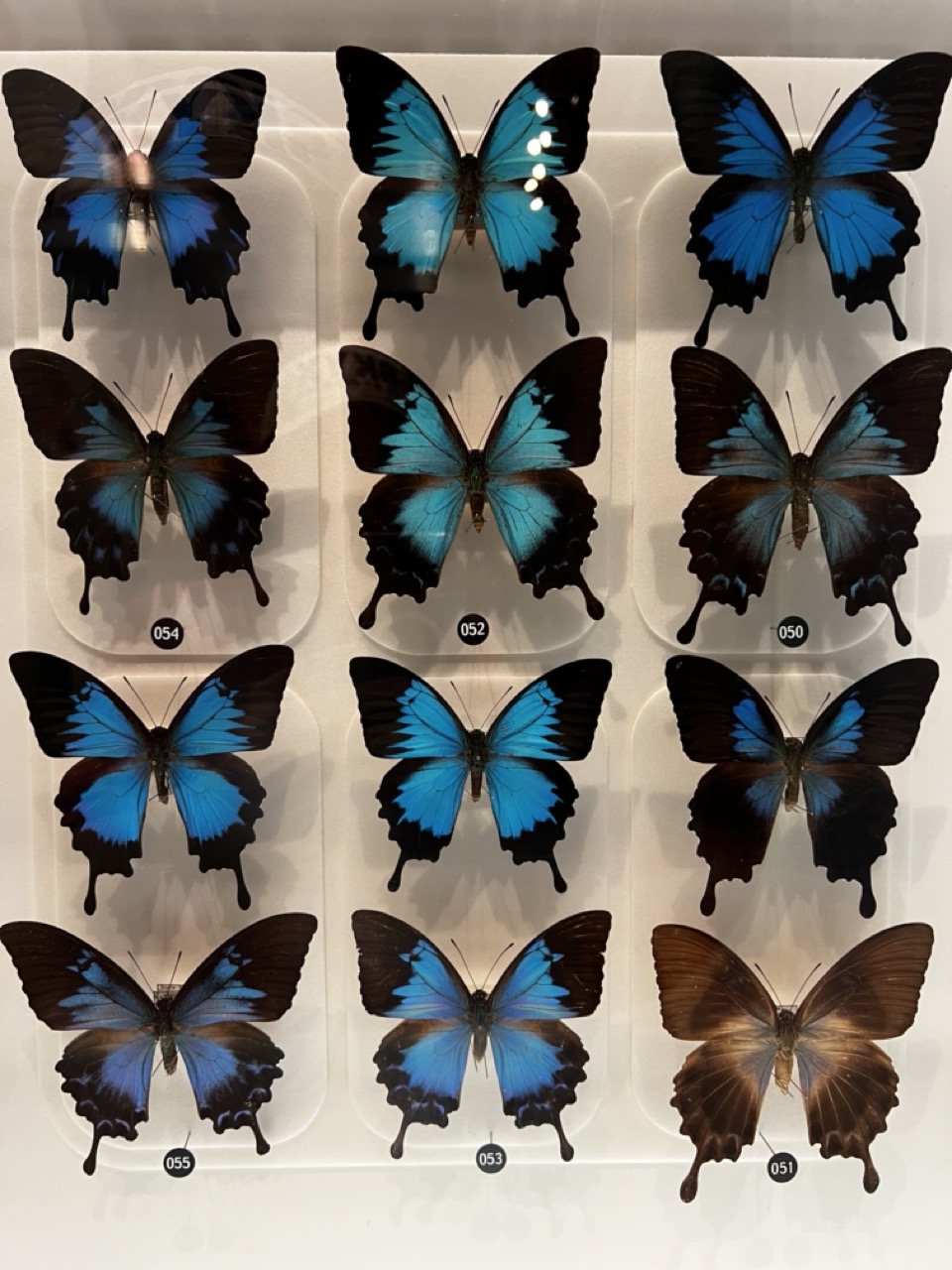

The Great Butterfly Lineup: A Pinned Performance
Rating: 7/10 (for the inherent beauty of the subject, not their willingness to pose)
This image presents a meticulously arranged display of a dozen pinned butterflies, showcasing nature's dazzling palette in a strictly organized grid. Against a clean, bright white background, these former flutterers are presented as static specimens, their vibrant blues, iridescent teals, and deep blacks dramatically contrasted with the sole brown outlier. Lined up in neat rows and columns, each delicate wing is perfectly spread and positioned, a testament to careful preservation, even if it lacks a certain *je ne sais quoi* in the 'life' department. Numbered tags subtly identify some of these silent subjects, reinforcing the cataloged nature of the collection.
From a photographic standpoint, the composition is undeniably orderly, if a bit stiff – a grid structure that emphasizes classification over creative dynamism. The lighting is commendably even and flat, which is excellent for scientific documentation, ensuring every iridescent scale catches the light without distracting shadows, though it leaves the scene feeling a tad sterile. The color is the undeniable star here; the intense blues pop spectacularly against the black wings and white backdrop, proving that even in stillness, these creatures are visual stunners. While these models aren't exactly known for their spontaneous movement or dynamic poses (they've been, shall we say, *permanently* styled), the photographer captured their striking patterns effectively within the constraints of a museum-like display. It's a portrait gallery where no one moves and everyone looks uniformly... pinned.
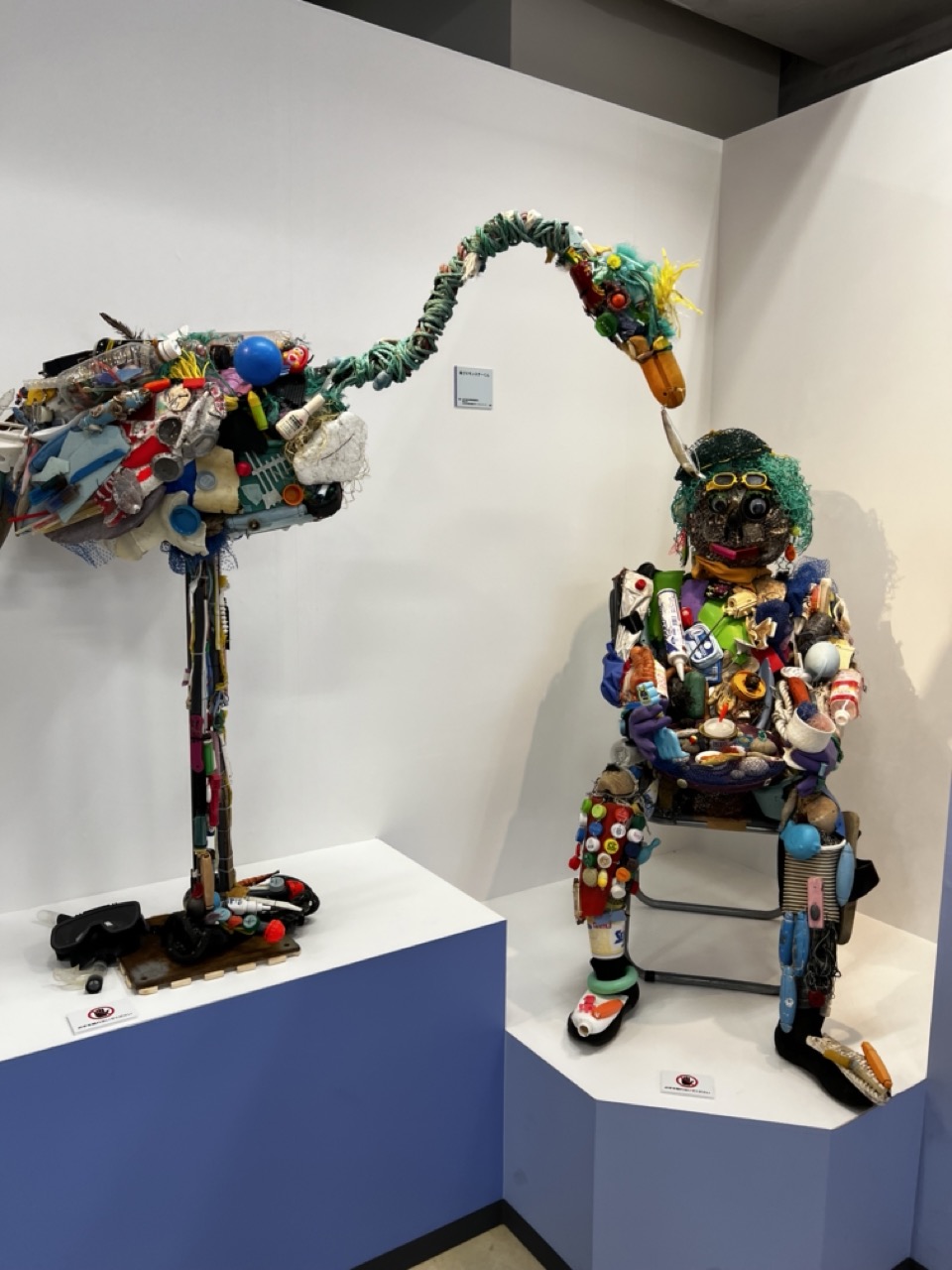

Trash Talkers
Rating: 8/10
Well, this isn't your grandma's porcelain collection. Here we have a truly... *unique* exhibition featuring two sculptures seemingly conjured from the depths of a recycling bin after a particularly wild party. The composition is straightforward, placing the two figures on clean, contrasting platforms – a bright blue one for the towering bird-like creature and a geometric white one for the seated figure. This simple staging against a stark white wall allows the chaotic energy and vibrant, albeit trashy, color palette of the sculptures to dominate. The lighting appears to be soft, even ambient light, typical of a gallery, which surprisingly manages to make the discarded plastic bottles, fabrics, and metal cans look almost... textural? It highlights the individual pieces of refuse without creating harsh shadows that might obscure the details of their construction.
The subject matter is undoubtedly the star here, pushing the boundaries of conventional art materials and earning a solid 8/10 for sheer audacity and originality. What's happening? It looks like a scene straight out of a post-apocalyptic children's book – the giant, long-necked creature made of who-knows-what is bending down towards the seated, equally bizarre figure, who seems to be holding a tray of... more trash? The mood is a fascinating mix of whimsical and slightly unsettling, a commentary, perhaps, on consumption and waste delivered with a punchy visual style. From a photography perspective, capturing such busy, multi-textured subjects without them becoming a formless blob of junk is a win; the focus is sharp, allowing you to see the individual bottle caps and bits of plastic that make up their strange forms. It's documentation of art, sure, but art that makes you question if your own trash can is a potential masterpiece waiting to happen.
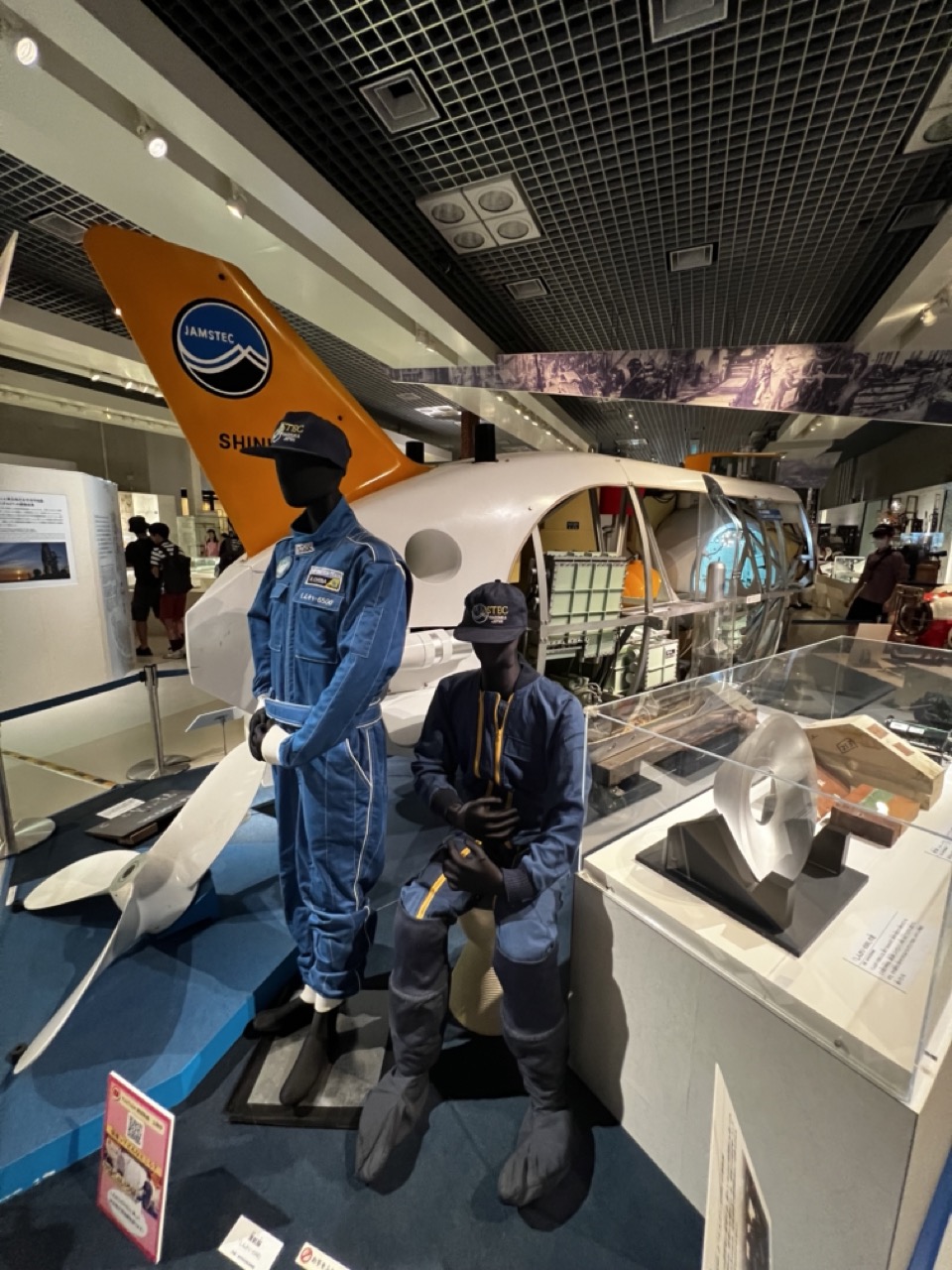

Title: Deep Dive into Museum Mayhem
Rating: 7/10
Step right up to witness the wonders of deep-sea exploration, as presented in this museum exhibit, featuring what appears to be a rather significant submersible, possibly the Shinkai 6500, recognizable by its distinct orange tail fin emblazoned with the JAMSTEC logo. Standing guard (or perhaps just standing around) are two mannequins sporting what look like vintage deep-sea suits, one striking a dramatic pose that screams "ready for adventure!" while the other is seated, seemingly contemplating the existential dread of spending eternity in a museum exhibit. The submersible itself is impressive, a feat of engineering laid bare, offering a glimpse into the brave world of descending into the crushing abyss. The mood is one of historical reverence for scientific achievement, slightly undercut by the slightly goofy stiffness of the mannequin crew who look like they've just failed an audition for a low-budget sci-fi flick.
From a photographic standpoint, this is a classic "trying to get everything in" museum shot. The composition crams the submersible, both mannequins, and a slew of foreground display cases into the frame, creating a somewhat cluttered feel. The lighting is standard museum fare – functional overhead lights that illuminate the exhibits but create predictable hot spots and glare on reflective surfaces, like those pesky display cases. The colors are dominated by the bold orange and blue of the main subjects against a neutral museum background, which is fine for documentation but lacks artistic flair. The background banner adds some historical context but feels a bit like an afterthought. Overall, it's a decent record of the exhibit, but a slightly different angle or tighter focus could have elevated the subject matter beyond mere reportage. Perhaps next time, advise the mannequins to strike a more dynamic pose.
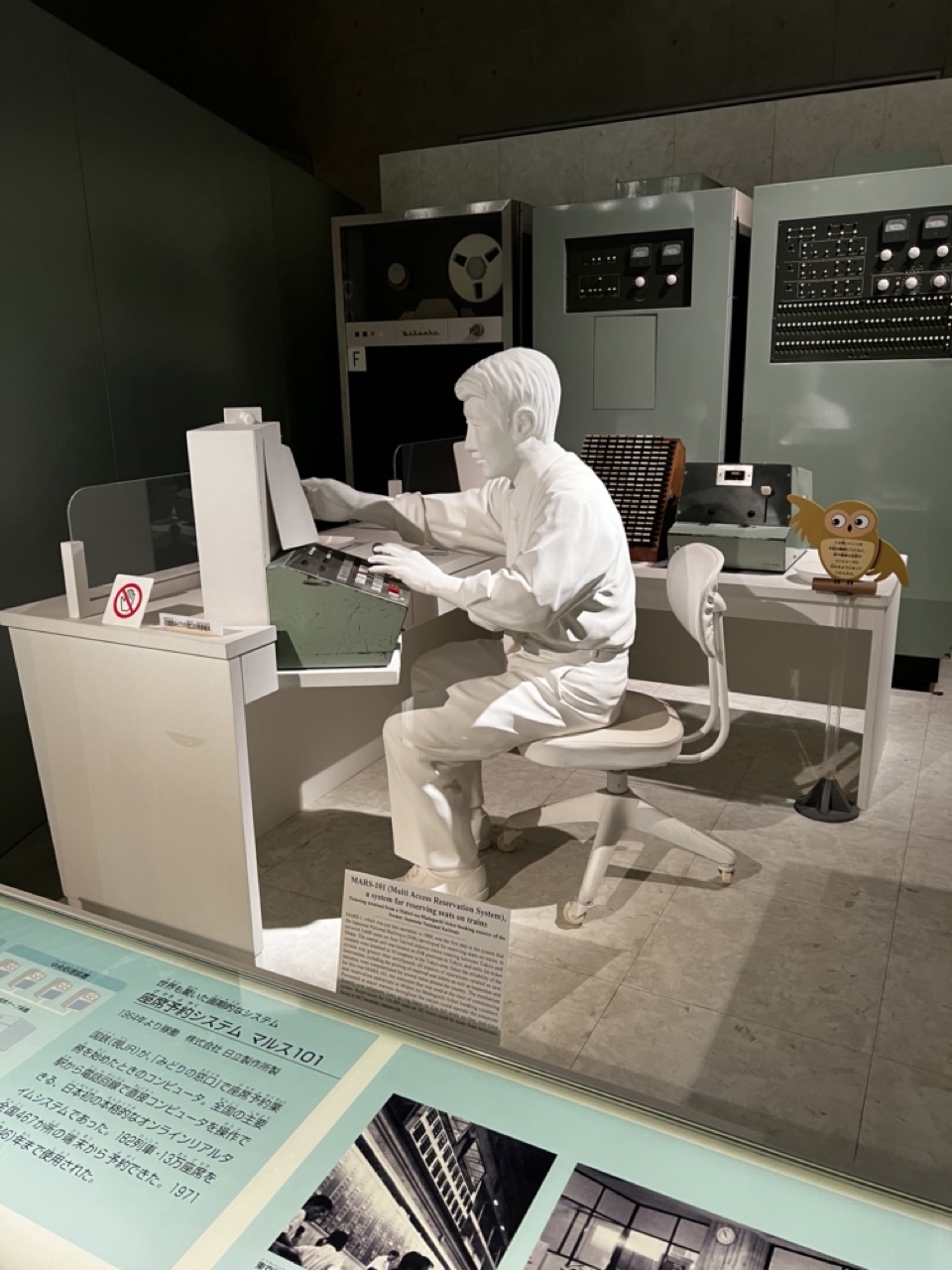

Vintage Tech Operator: The Mannequin & The Machine
Rating: 8/10 (for the fascinating historical subject matter)
Stepping into a blast from the past, this museum exhibit showcases the formidable MARS-101, an early train reservation system, complete with a stiff-as-a-board mannequin demonstrating its use. The scene is set around a bulky, green-hued computer terminal, where our silent operator sits perched, fingers hovering eternally over the keyboard, embodying the dedicated human interface required by these giants of yesteryear. Behind this setup loom the imposing, battleship-grey computer units – tape drives, control panels, and all – a reminder of the sheer physical presence early computing demanded. Adding a touch of unexpected whimsy, a wooden owl figure keeps watch from the desk, perhaps the system's only living companion or simply a quirky museum addition to lighten the mood of technological solemnity. The foreground is dominated by a glass display case, unfortunately introducing reflections but also providing vital context about the system's history in Japanese, describing its role in revolutionizing train seat reservations starting in 1964.
From a photographic perspective, the shot captures the subject adequately, but the museum environment presents typical challenges. The lighting is a mixed bag; while the mannequin and desk area are reasonably well-lit, the vital background machinery recedes into shadow, diminishing their imposing scale and intricate details. Compositionally, the presence of the reflective glass display case in the lower third is a significant distraction, intruding upon the frame and creating competing points of interest with the text and reflections. The muted color palette of the scene – mostly greens, greys, and whites – accurately reflects the era's industrial design but makes for a less visually dynamic image. Despite these technical limitations inherent in museum photography (unless you break out a flash, which is usually forbidden, probably for good reason!), the image successfully conveys the scale and complexity of early online reservation systems, offering a humorous glimpse into a bygone era where a "multi-access" system meant connecting a modest 467 terminals to a behemoth in a room.
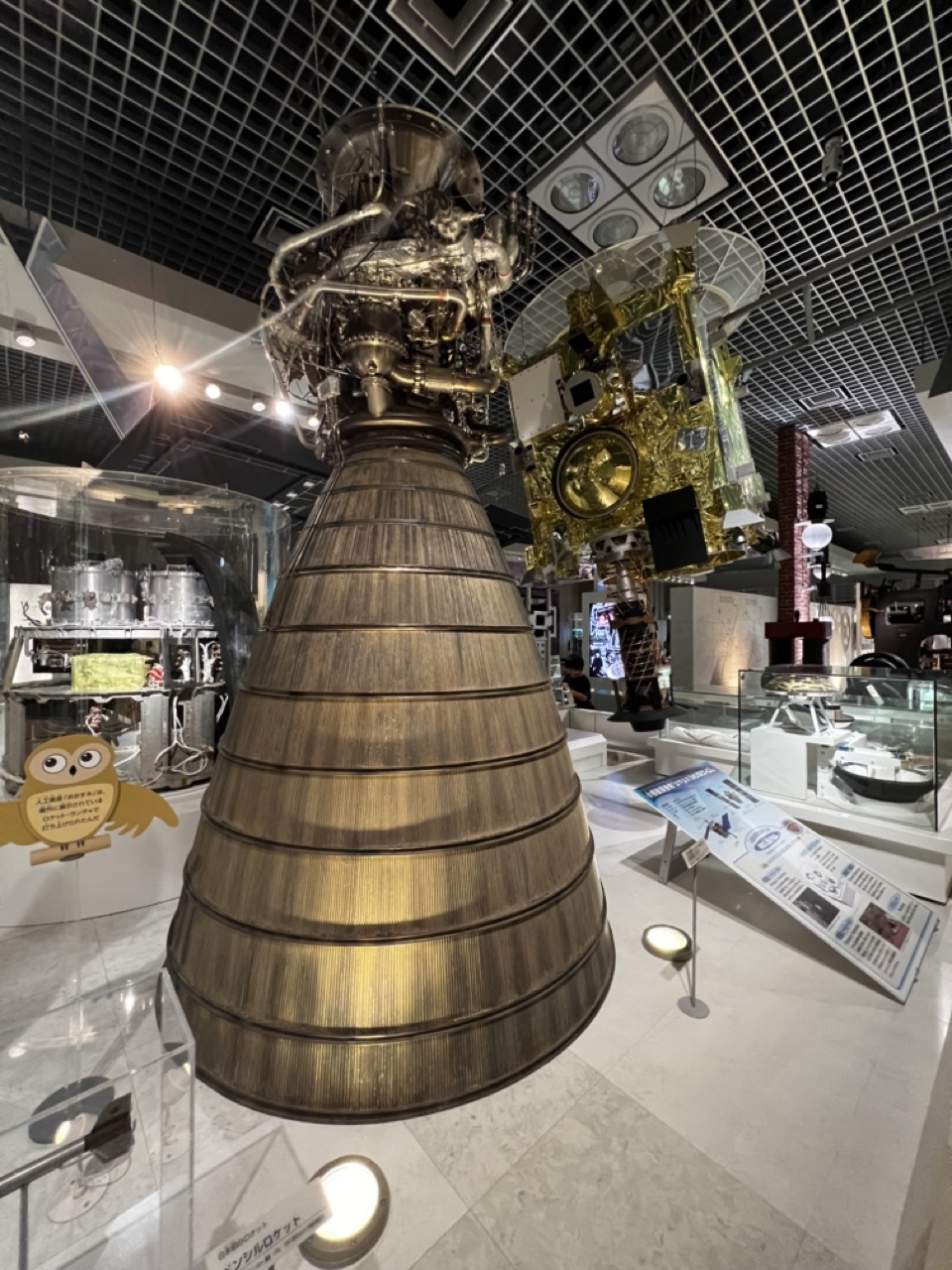

Space Hardware Showcase
Rating: 7/10
This image throws you right into a museum of epic proportions, featuring a truly gargantuan rocket engine nozzle taking center stage. The subject matter alone is a solid 9/10 for any space enthusiast, a magnificent piece of engineering that dwarfs everything around it. What's happening is pretty straightforward: we're looking at impressive space hardware on display, bathed in the dramatic, slightly uneven lighting of the exhibition hall. The mood is one of awe mixed with the slightly overwhelming feel of a busy museum – there's a lot to look at. Compositionally, the huge nozzle dominates the frame, drawing your eye up its ribbed, metallic structure. This perspective emphasizes its scale but leaves the gold satellite model floating somewhat awkwardly to the right, slightly cropped at the top. The lighting plays up the metallic textures beautifully, creating shimmering highlights and deep shadows, turning the nozzle into a bronze giant and the satellite into a dazzling, intricate sculpture. The color palette is dominated by these warm metallic tones, contrasted with the cooler whites and grays of the museum floor and background elements.
From a photography perspective, this shot captures the essence of the display but feels like a quick snap rather than a carefully composed piece. The style is that of a visitor documenting what they saw, possibly with a phone given the slight wide-angle distortion. Pertinent objects abound: the star of the show is clearly the rocket nozzle, but the golden satellite is also a major element, reflecting light with gusto. In the background, other blurred exhibits, display cases, and a rather endearing sign featuring an owl character in Japanese add to the museum setting chaos. The ceiling grid and spotlights are also prominent elements defining the space. While the sheer scale of the engine makes for a striking subject, the composition could have been improved by perhaps stepping back to better include the satellite or finding an angle that minimizes the background clutter. The dramatic lighting is great for the metals but leaves some areas, like the lower section of the nozzle, a bit dark. Overall, it's a decent documentary shot of impressive objects, full of fascinating detail for the technically minded, even if it lacks a bit of photographic polish.
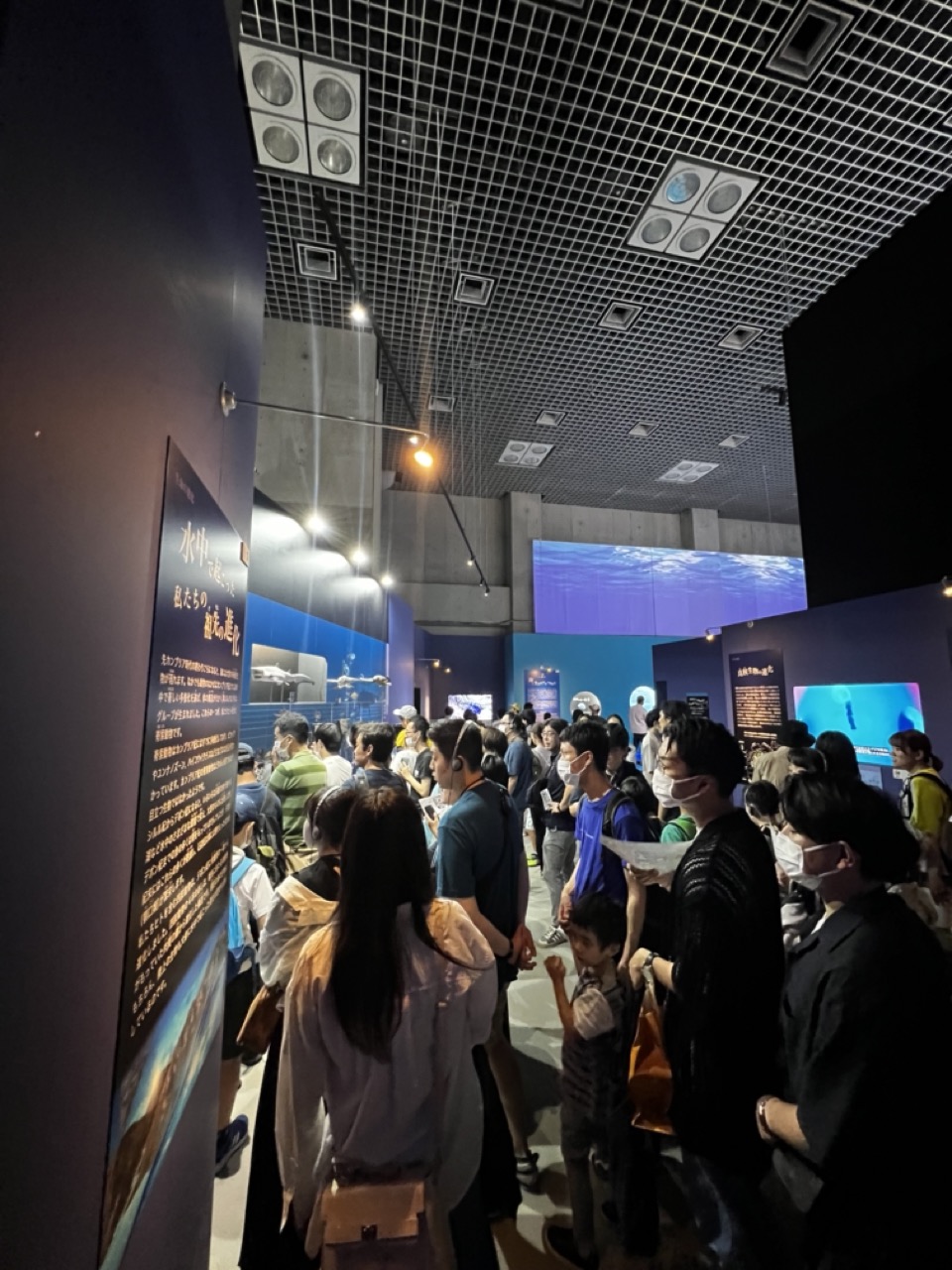

The Great Indoors Aquarium Shuffle
Rating: Subject 6/10
Step right up and experience the thrilling reality of visiting a popular exhibit: trying to see anything at all! This candid shot perfectly encapsulates the bustling atmosphere of what appears to be a museum or aquarium display area. The composition places us right within the crowd, looking towards the exhibits on the far wall and large screens in the background. On the left, a significant portion of a large information panel, filled with text and images, dominates the foreground, although its message is likely lost in the sea of heads. The visual focus quickly shifts to the myriad of people intently (or patiently) waiting or viewing the glowing blue displays depicting underwater scenes. It's a classic wide shot capturing the overall scene rather than focusing on individual details, which definitely nails the "being there" feeling, complete with the slight claustrophobia.
The lighting is typical of such indoor venues – a mix of overhead ambient light, specific spotlights, and the bright glow from the screens, creating a somewhat uneven illumination that highlights some areas while leaving others in shadow. The color palette leans towards blues and greens from the aquatic displays, contrasting with the darker walls and the diverse range of clothing colors worn by the visitors. The ceiling, a distinct grid pattern, adds an interesting geometric element that guides the eye upwards, perhaps hinting at the scale of the space, while also possibly hiding the true source of some challenging lighting. Overall, the mood is one of engaged collective experience, everyone sharing the space and the content, even if personal viewing angles are less than ideal. It's a very real portrayal of navigating popular cultural attractions, where the subject is as much the crowd itself as what they are looking at.
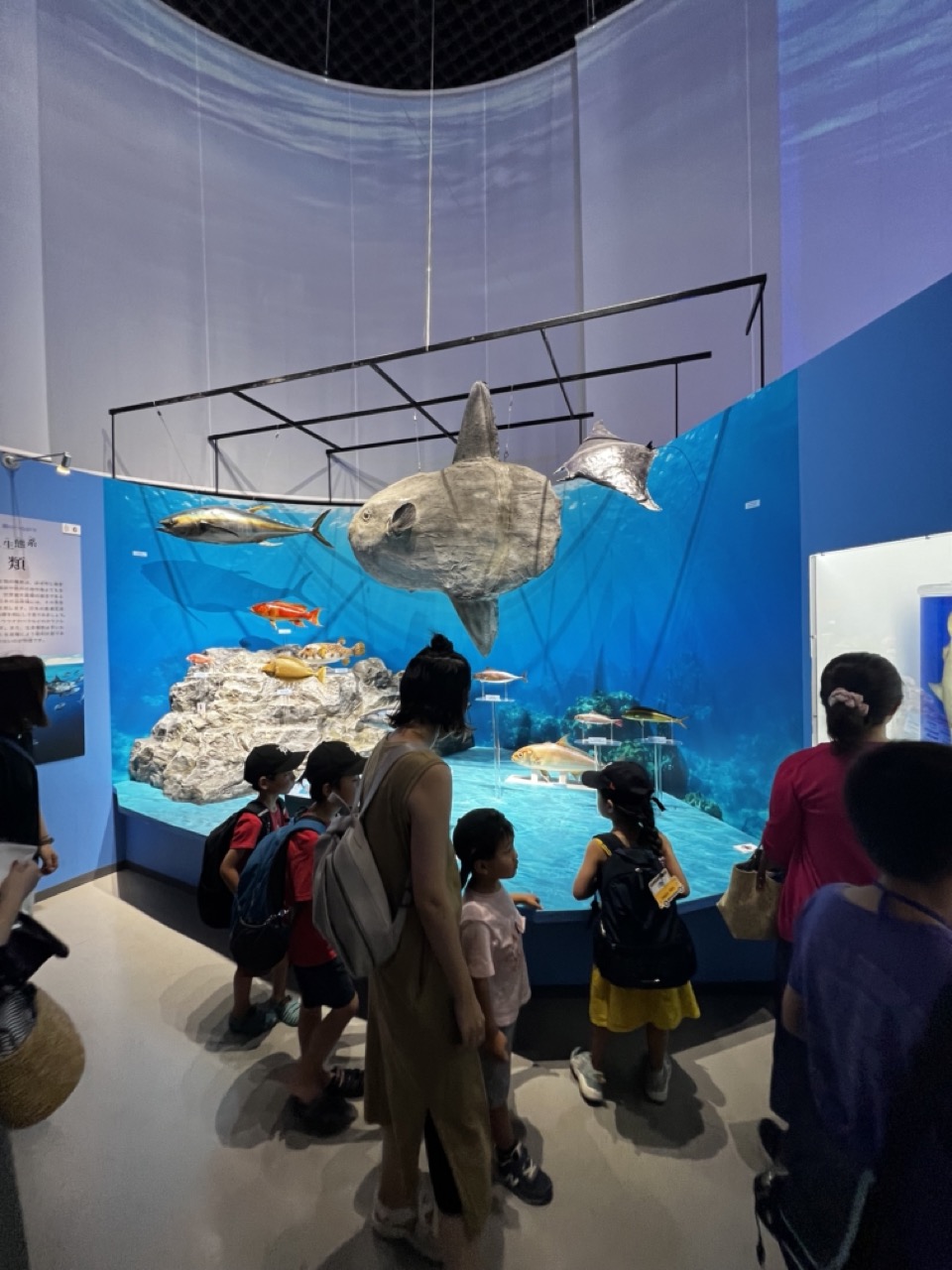

Museum Marvels Under the Sea... of People
Rating: 7/10
Stepping into what feels like a slice of the deep blue sea transplanted indoors, we find ourselves among a group of curious visitors, primarily families, engrossed in a captivating marine life exhibit. The star of the show, undoubtedly, is the colossal model of a sunfish hanging dramatically overhead, its imposing size dwarfing the people below. Sharing the suspended stage are models of a sleek tuna and a graceful ray, adding dynamic movement to the artificial ocean scene. Below them, a detailed diorama presents a vibrant coral reef ecosystem populated with smaller fish models, resting on realistic rock formations. The mood is one of calm fascination and educational engagement, a quiet moment of connection between humans and the marvels of the ocean, albeit in a simulated environment.
Photographically speaking, this image offers a natural, documentary-style snapshot of a museum visit. The composition, captured from a slightly low vantage point, effectively emphasizes the scale of the hanging models and the exhibit space, drawing the viewer's eye upwards towards the giant sunfish which dominates the central frame (someone clearly skipped leg day). The lighting is the ambient illumination from the exhibit itself, providing a decent exposure but lending a cool, blue cast across the scene, which is fitting given the theme, though not particularly dramatic. While it’s a solid capture of the scene and the interaction, the angle feels a touch informal, characteristic of a quick snap during a busy outing. It succeeds in conveying the sense of wonder that such exhibits can inspire, even if the biggest challenge for the photographer might have been convincing the kids to look *at* the fish models instead of just pointing enthusiastically.
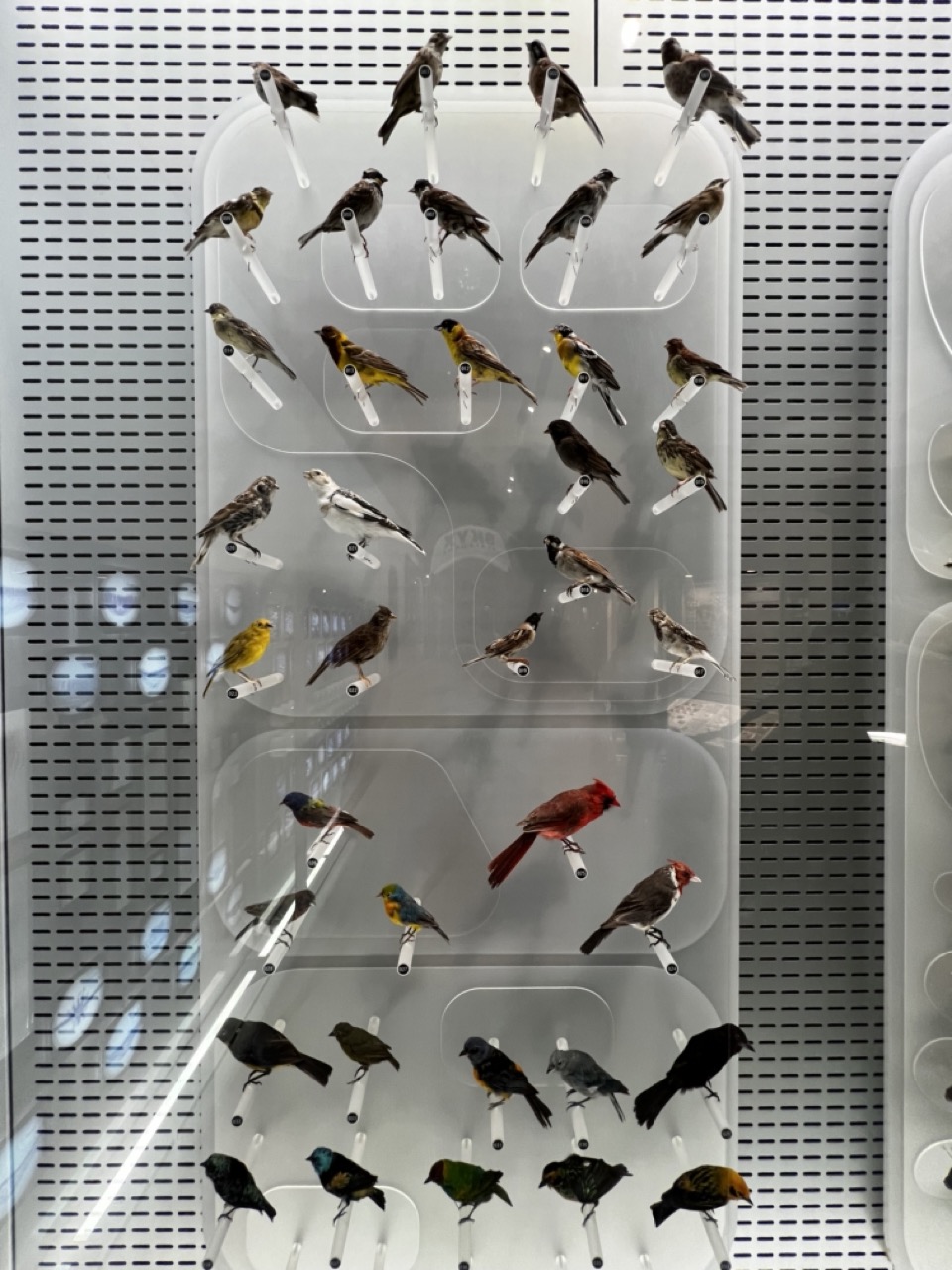

Avian Arrest: A Stiff Convention
Rating: 7/10 - Points for variety, but they're not exactly bringing the *life* to the party.
This shot captures a rather formal gathering of avian specimens, stiffly posed for posterity in a well-lit display case. It appears to be a museum exhibit, showcasing a collection of taxidermied birds mounted on clear plastic stands, organized in neat rows and columns. What's happening is... well, not much, which is rather the point for these permanently posed participants. The mood is decidedly static and educational, perhaps a touch melancholic given the subjects' state, but mostly just clean and organized like a well-curated biological catalogue. The photographic style is documentary, aiming for clarity and detail over artistic flair, capturing the subjects and their sterile environment head-on.
From a photographic perspective, the composition is straightforward, a grid of subjects against a grid background, which is visually repetitive but effective for a collection display. The lighting seems to be consistent internal illumination, which is great for showing detail on each bird but results in a rather flat image, lacking dynamic shadows or highlights. Color is varied due to the diverse species on display, ranging from vibrant reds and yellows to more subdued browns and grays, offering pockets of visual interest within the otherwise clinical setting. The major challenge here is dealing with reflections off the glass case, which adds an unwanted layer of visual noise and makes some birds less clear. The pertinent objects are the birds themselves, their clear plastic perches, and the grid-patterned panels forming the background within the display, all contributing to the sterile, organized aesthetic of this eternal bird convention.
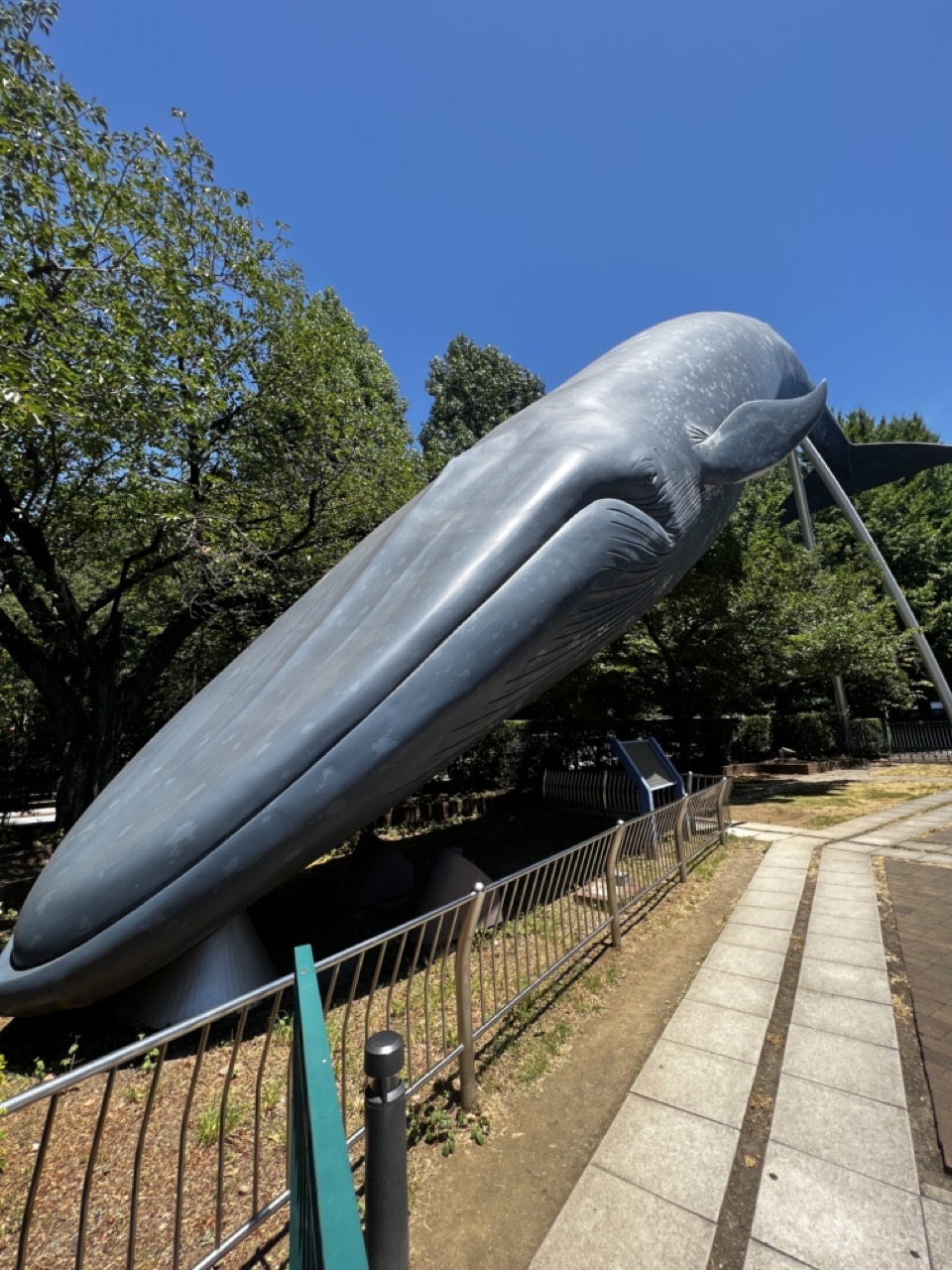

The Landlocked Leviathan
Rating: 8/10
Well, someone clearly misplaced their giant blue whale. Here we see an enormous blue whale sculpture comfortably (or perhaps awkwardly) resting on some silver legs in what appears to be a park. It dominates the frame, angling upwards dramatically towards a very blue, clear sky. The scene is quite surreal, like a marine biology exhibit escaped its enclosure and decided to take a nap amongst the trees. You can spot a metal fence lining a pathway in the foreground, and beyond the whale, more trees and hints of park infrastructure, including what looks like a small blue slide peaking out from underneath. The mood is bright and sunny, slightly whimsical given the subject matter, suggesting a pleasant day out, albeit one with a massive cetacean visitor.
From a photographic standpoint, the low-angle perspective is a smart choice, emphasizing the sheer scale of the whale and making it feel truly colossal against the sky. However, it does introduce some perspective distortion, making the tail end seem further away than it is. The composition is dynamic, leading the eye along the curve of the whale's body. The lighting is classic midday sun – bright, with harsh shadows, which works okay here to define the whale's form but isn't the most flattering for detail. The colors are vibrant under the strong light: the cool blue of the whale, the deep greens of the trees, and the rich blue of the sky create a pleasing palette typical of a sunny summer day shot with a modern camera phone. It's a snapshot style, capturing a moment of discovery or novelty in a public space.
Loading map...